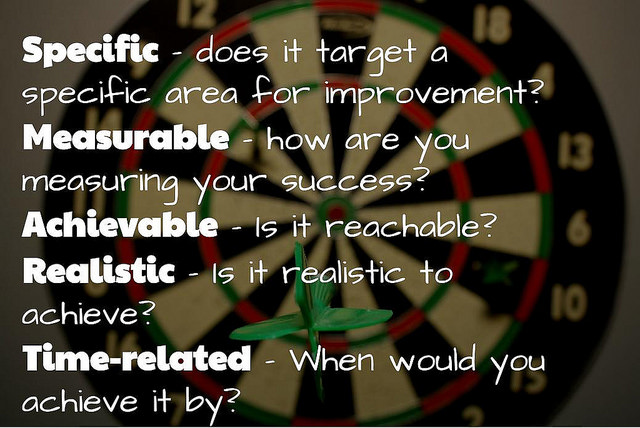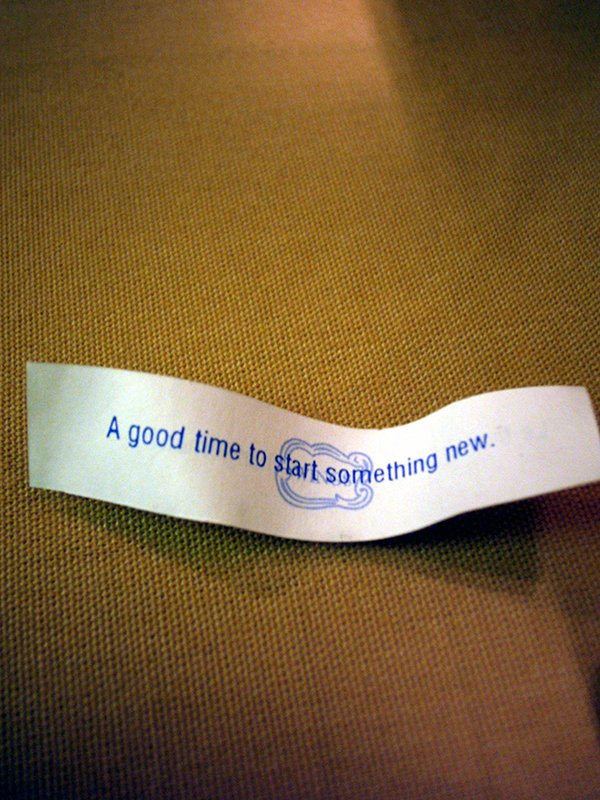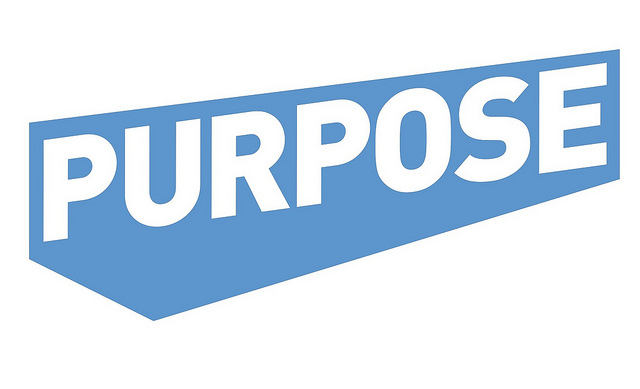|
|
|
Wednesday, January 2nd, 2019
It is the beginning of the
year and beginnings are when people tend to reflect and choose.
And maybe change direction.
Not just at the beginning of a
new year, but any beginning — new month, new home, new relationship, new pet,
new job, new boss, new colleague(s), new outfit, new [you name it].
I’m as prone to this as
anyone, although my internal editor, who provides constant commentary — mostly
irreverent, rarely complimentary — on my actions, ideas and thoughts, thinks
requiring a beginning to start something is pretty silly.
When we start something has
little to do with whether we finish it, let alone if it’s a success.
We all know that starting is
easy, especially in comparison to sustaining the effort.
Instead of spending all your energy on the planning, save a good deal for sustaining what you started and staying flexible, so you can address challenges quickly.
Image credit Marco Verch
Posted in Personal Growth | No Comments »
Monday, October 8th, 2018

Poking through 12+ years of posts I find information that’s as useful now as when it was written.
Golden Oldies is a collection of the most relevant and timeless posts during that time.
Last Monday we considered whether your goals were your own or dictated by outside pressure. Today, we’ll look at something I wrote way back in2006 when I started this blog — my approach to making goals and to-do lists a positive experience, i.e., work.
Read other Golden Oldies here.
A client sent me a list of what he plans to accomplish in Q4—it was a very long list. I find most people have similar lists and, although all the items are necessary, the list can be daunting.
As opposed to listing just goals, most people’s lists include everything they need/want to accomplish in that time frame, both goals and to-do’s, hence the long list.
You’ll still need to do the work, but here’s a simple trick to help tame your list, raise your productivity, and give yourself more feelings of accomplishment and fewer of frustration.
I’ve found that the items on these lists fall into three categories:
- Normal work: includes all the things that you need to do that quarter that are part of your job description. (executing marketing plans, making sales calls, hiring staff; doing reviews, etc.)
- Goals: in addition to normal, daily tasks (increase manufacturing output 8% in Q4; write operating plan for 2007; reduce attrition 10%, etc.)
- Behavioral changes: refers to MAP changes (improve attitude; give and accept constructive criticism)
Goals usually require a great deal more planning and take longer to come to fruition, hence the longer deadlines. They are often more strategic and can involve other people’s activities. One major and two minor goals are the most that can be handled efficiently and be accomplished.
Normal work doesn’t need to list every single thing you do. It’s more a matter of personal taste whether you list each thing or just the major tasks that aren’t ongoing on a daily basis. When listing major tasks, e.g., hiring, be sure to set a deadline, be reasonable, but a deadline will keep you on track and keep the item from getting pushed to the back burner. It’s easy to mix up goals and work. For example, you may think of filling a req as a goal, but it’s really part of your normal work as a manager.
Behavioral changes need to be specific, so, rather than “improve attitude,” specify three things that will accomplish that (stay positive, smile, be friendly). MAP changes require staying aware until the desired change becomes a habit and three is about the max most people can monitor at once and, even that, can be a stretch. However, if you made even one MAP change each quarter the over all change in that year would be phenomenal.
Now for the trick. Using three columns with these headings,
- drag and drop your list into the appropriate column;
- keep shuffling them until you’re sure each is in the right place;
- prioritize them; and
- move any extra items (more than three each) from Behaviors or Goals to a separate holding doc—that’s why prioritizing them is so important.
Print Behavioral changes and stick them on your monitor, tape them to the dashboard, up them on a wall—somewhere you will always see it because out of site is out of mind and you need to stay constantly aware to build the habit.
Using the deadlines, incorporate the others into your normal planning process.
Be sure to do a reality check using normal and worst case analysis. You aren’t Super(wo)man, so be sure that what you want to accomplish can be done. If not, adjust your lists accordingly, keeping it firmly in mind that your object is to increase your productivity, not your frustration.
Finally, once you’re clear on the process, share it with your organization, not just the managers, but with everyone
Image credit: Aaron Davis
Posted in Golden Oldies, Personal Growth | No Comments »
Monday, October 1st, 2018

Poking through 11+ years of posts I find information that’s as useful now as when it was written.
Golden Oldies is a collection of the most relevant and timeless posts during that time.
Last Wednesday I noted with the year three quarters over people were likely to start obsessing and stressing about accomplishing the goals they set last January. I also said I would discuss goals further today.
Topping the list of choosing goals is the need to identify whose goals are — as explained in this post from 2009. Next Monday I’ll share one more bit of insight about goals from way back in 2006.
Read other Golden Oldies here.
This might come as a shock, but there is no Eleventh Commandment stating, “Thou shalt place thy career above all things in thy life and draw all sustenance, mental and spiritual, as well as economic, from it.”
For decades I’ve held (and preached) the career-as-part-of-life MAP (mindset, attitude, philosophy™), as opposed to the reverse.
Life is LARGE; career is but a small part of the whole. A major problem is created when the adjectives (and, therefore, the attitudes) are reversed.
Steve Roesler has a great post on a better way to look at your work and your life.
“The issue of work-life balance is about what kind of a life you want to have. Work plays a part in that. Decisions that you make about life determine how much work and what kind of work you do. Spending time getting clear about who you are and how you are talented is time well-spent. You may not even like the answer at first. It may conflict with expectations from you, your family, the community, and even society at large.
Maybe that’s the place to start. For those who work best with a label, perhaps Life Integration would offer a better target than Work-Life Balance.”
I like that—Life Integration.
Very few people choose how to die, but too many don’t choose how to live.
They allow the expectations of parents, educators, friends, colleagues, movies, society-in-general and the ever ubiquitous ‘they’ to choose for them.
Most will deny this publicly, but anyone who honestly remembers the power of peer pressure in school will privately admit that it doesn’t cease to exist upon graduation; in fact the pressures increase dramatically while becoming more covert.
Few successful people care to admit that the goals for which they are working and even how they spend their non-work time are more about fitting in than personal desire.
They chase the goals and do the things that ‘everybody’ is doing in the name of being ‘with it’. And that includes “work/life balance” and “having it all right now.”
So the net time you are ready to tear your hair out STOP; stop, take a step back and honestly determine whose goals you are trying to reach.
The answer may surprise you.
Image credit: arkitekt on sxc.hu
Posted in Personal Growth | 1 Comment »
Thursday, July 26th, 2018

I work for a channel partner within the software industry. One reason I chose to work at my current job is the fact that we align with the customers needs, find a product that fits and help implement it. I appreciate that we go to market not because of a marketing brochure, we go to market with the clients needs first.
I had an opportunity today to learn about a new vendor that is in the space I focus, workload automation.
A big word for an industry that runs everything from your bank transactions to the Starbucks app (true story). This vendor is new to me but fits a segment of the market that we are not currently meeting. It does most things that our customers need and the company seems ethical.
I say all of this to tell you it gave me some hope today. I am in a position now where I am helping to shape the direction of my company and leave a mark.
Is that enough to go to work? I find that having purpose helps a lot. It gives greater satisfaction and focus when you have purpose.
Of course, my family helps in this regard, but family doesn’t always help with burnout. Sometimes it contributes when you’re getting woken up several times a night by the baby! Money can help sometimes, too, but I find it ultimately empty. It leaves you wanting more and never satisfied.
For me, I have found what gives me the most purpose is when my input is desired, I heard and I contributed.
What gives you purpose?
Image credit: leesean
Posted in Motivation, Personal Growth, Ryan's Journal | No Comments »
Thursday, August 3rd, 2017

I touched on this a bit last week with regards to what motivates people. It’s different for all of us of course, but there is something that drives us.
Whenever I am particularly candid with myself, I find that fear of disappointing others is always high on my list. But I also have a drive to be unique.
Sometimes I look at lists that show how only a few people have achieved something and I make it my goal to join that group.
A bucket list item of mine is to climb the seven summits. These are the highest peaks on each continent. Very few have done it as it requires an immense amount of time and money. I figure if I can accomplish that then I have done something right in other areas if my life. Enough about me though.
What motivates others?
I had a conversation today with a fellow sales rep. She has been successful in the past couple of years and has accomplished some life goals. One was paying off debt. That’s a big one. She also had her eye on a few personal objects, one being a Rolex.
Last year she said she had the ability to finally buy one and not feel guilty. I realize most out there probably have other priorities, but this was hers.
As she began her search for a Rolex that would fit her tastes she was surprised to learn that her company had went ahead and purchased one for her as a gift.
Her boss had overheard her saying how she wanted one and decided to reward her hard work by giving the Rolex as a gift. My friend said this was the most meaningful item she had ever received in her career.
When I asked why she said it wasn’t because of the watch. It was the fact that someone took the time to listen to her, remember what she said and care.
Her boss didn’t have to give the gift, but they understood that we are all motivated in different ways. For my friend that motivation was to feel validated.
As I go about my week I am going to take the time to see what motivates those around me.
What motivates you?
Image credit: hypo-physe
Posted in Motivation, Ryan's Journal | No Comments »
Friday, March 7th, 2014
A Friday series exploring Startups and the people who make them go. Read all If the Shoe Fits posts here

Two questions:
- Are you working to build a culture of innovation in your startup?
- Do you live the startup mindset of 100 hour weeks, all night hackathons, 24/7 availability and no time for vacations?
If you answered ‘yes’ to both you’re in trouble, because a yes to the second sooner or later will nullify the first.
According to Marc Barros, co-founder and former CEO of Contour, there are five actions you can take to avoid killing off your golden egg, i.e., your culture of innovation.
Here they are, with my caveats (follow the link to read the originals).
- Offer Unlimited Vacation: while this isn’t always possible, and may not even work, making sure your people, including founders, take real vacations, which means no email, texts or emergencies. They should last a minimum of three days, but a week is much better. And if having you/them gone for that time will really crash and burn the company you have bigger problems than you realize.
- Let Employees Work Remotely: in addition to working remotely physically whenever possible be sure to provide an environment that promotes mental remoteness. In other words, they don’t have to think/work/act like you to achieve the desired results.
- Ditch the Meetings: make sure that those you do have are short and productive.
- Nix Department Goals: goals at all levels—department, team, personal, should always focus on what needs to happen to achieve specific, major, annual company goals (never more than three).
- Give Plenty of Feedback: just don’t make giving constant feedback an excuse or cover for micromanaging.
One of the biggest actions that Barros doesn’t mention, but is implicit in what he does, is trust.
If bosses don’t believe that their people really do care that the company succeeds and trusts them to make it happen then they will be unable to implement any of this.
In the comments section, Mick Thornton, who worked at Safeco Insurance (definitely large and definitely old-line), talks about the success of the team he was on.
The biggest keys to success for our team was a manager that understood broad goals saying things like “Here’s what we want the end to look like, now go figure it out. Let me know if things start to slide or go south, otherwise work how you want to meet the deliverable.”
Image credit: HikingArtist
Posted in Culture, If the Shoe Fits, Innovation | No Comments »
Tuesday, June 9th, 2009
Every time I hear a pundit ask a (positional) leader about her vision or Wall Street condemns someone for not having a vision that they consider viable I find myself wanting to bop the questioner.
 I’m not into visions. I’m not into visions.
Visions are what Sherlock Holmes had when he was smoking opium; they’re what dance in kids heads before Christmas; they’re what the religious see on slices of bread and potato chips.
There’s an old saying that the difference between a dream and a goal is a plan.
I equate visions to dreams until there’s an executable plan and management with the moxie to implement it. (That’s why I don’t believe we’ll see universal healthcare any time soon—lots of visions, lots of rhetoric, little management and less moxie.)
Of course, you have to use the lingua franca of the day when communicating and that means calling your goal a vision, which is fine—as long as you really understand what’s required to make it a reality.
Your comments—priceless
Don’t miss a post, subscribe via RSS or EMAIL
Image credit: ZedBee|Zoë Power on flickr
Posted in About Leadership, Leadership Skills, What Leaders DO | 6 Comments »
|
 Subscribe to
Subscribe to
MAPping Company Success
About Miki 
Clarify your exec summary, website, etc.
Have a quick question or just want to chat? Feel free to write or call me at 360.335.8054
The 12 Ingredients of a Fillable Req
CheatSheet for InterviewERS
CheatSheet for InterviewEEs™
Give your mind a rest. Here are 4 quick ways to get rid of kinks, break a logjam or juice your creativity!
Creative mousing
Bubblewrap!
Animal innovation
Brain teaser
The latest disaster is here at home; donate to the East Coast recovery efforts now!
Text REDCROSS to 90999 to make a $10 donation or call 00.733.2767. $10 really really does make a difference and you'll never miss it.
And always donate what you can whenever you can
The following accept cash and in-kind donations: Doctors Without Borders, UNICEF, Red Cross, World Food Program, Save the Children
*/
?>About Miki
About KG
Clarify your exec summary, website, marketing collateral, etc.
Have a question or just want to chat @ no cost? Feel free to write
Download useful assistance now.
Entrepreneurs face difficulties that are hard for most people to imagine, let alone understand. You can find anonymous help and connections that do understand at 7 cups of tea.
Crises never end.
$10 really does make a difference and you’ll never miss it,
while $10 a month has exponential power.
Always donate what you can whenever you can.
The following accept cash and in-kind donations:
|









 I’m not into visions.
I’m not into visions.
